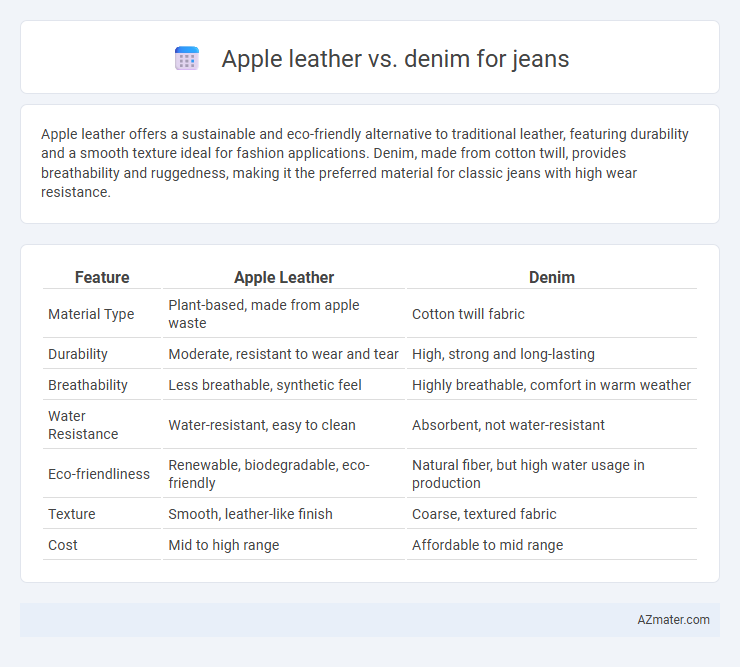Apple leather offers a sustainable and eco-friendly alternative to traditional leather, featuring durability and a smooth texture ideal for fashion applications. Denim, made from cotton twill, provides breathability and ruggedness, making it the preferred material for classic jeans with high wear resistance.
Table of Comparison
| Feature | Apple Leather | Denim |
|---|---|---|
| Material Type | Plant-based, made from apple waste | Cotton twill fabric |
| Durability | Moderate, resistant to wear and tear | High, strong and long-lasting |
| Breathability | Less breathable, synthetic feel | Highly breathable, comfort in warm weather |
| Water Resistance | Water-resistant, easy to clean | Absorbent, not water-resistant |
| Eco-friendliness | Renewable, biodegradable, eco-friendly | Natural fiber, but high water usage in production |
| Texture | Smooth, leather-like finish | Coarse, textured fabric |
| Cost | Mid to high range | Affordable to mid range |
Introduction: Apple Leather and Denim in Jeans
Apple leather, a sustainable alternative made from apple waste, offers a cruelty-free and eco-friendly option for jean accents and patches, combining durability with a unique texture. Denim, the traditional fabric for jeans, is prized for its strength, timeless style, and comfort, crafted from tightly woven cotton twill. Comparing apple leather and denim highlights the growing trend toward innovative, environmentally conscious materials in denim apparel manufacturing.
Material Composition: Apple Leather vs Denim
Apple leather is a sustainable material made from apple peel waste combined with polyurethane, offering a vegan alternative to traditional leather with a soft, smooth texture, while denim is a durable fabric woven from cotton fibers characterized by its twill weave and rugged feel. Apple leather's composition results in lightweight, water-resistant properties, whereas denim's natural cotton composition provides breathability and long-lasting wear. Choosing between apple leather and denim for jeans depends on preferences for sustainability, texture, and fabric functionality.
Environmental Impact and Sustainability
Apple leather, made from apple waste, significantly reduces landfill contributions and lowers carbon emissions compared to traditional leather. Denim production typically involves high water usage and chemical treatments, raising concerns about pollution and resource depletion. Choosing apple leather over denim promotes sustainable fashion by utilizing circular economy principles and minimizing environmental harm.
Durability and Longevity Comparison
Apple leather offers moderate durability with resistance to cracking and peeling, making it a sustainable alternative to traditional leather, but it may show wear faster with frequent bending and stretching. Denim, renowned for its robust weave and high tensile strength, provides superior longevity and stands up well to repeated washing and abrasion, making it ideal for everyday wear jeans. Choosing denim ensures extended garment life, whereas apple leather requires more delicate care to maintain its appearance and durability over time.
Comfort and Wearability Factors
Apple leather offers superior comfort due to its soft, breathable, and flexible texture, making it ideal for prolonged wear in jeans. Denim, while durable and providing excellent abrasion resistance, can initially feel stiff but softens over time with wear and washing. Wearability favors apple leather in warmer conditions due to its moisture-wicking properties, whereas denim remains preferred for rugged durability and classic style.
Style and Aesthetic Differences
Apple leather offers a sleek, modern appearance with a smooth texture and subtle sheen, lending a polished and edgy vibe to jeans. Denim, known for its classic, rugged look, features a textured weave and natural fading that emphasizes casual and timeless style. The contrast between the glossy finish of apple leather and the matte, structured feel of denim creates distinct aesthetic choices for fashion statements.
Maintenance and Care Requirements
Apple leather requires gentle cleaning with a damp cloth and mild soap, avoiding excessive water to maintain its texture and durability, while denim can be machine washed but often needs color-safe detergents to prevent fading. Apple leather benefits from periodic application of leather conditioners to prevent cracking, whereas denim thrives with occasional washing and minimal ironing to preserve fabric integrity. Both materials respond well to air drying, but apple leather should never be exposed to direct heat sources, in contrast to denim's tolerance for low-heat tumble drying.
Cost Analysis: Apple Leather vs Denim Jeans
Apple leather jeans generally have a higher upfront cost compared to traditional denim due to the innovative processing and sustainable materials involved in creating apple leather fabric. Denim jeans benefit from mass production and widespread availability, resulting in lower manufacturing and retail prices. Over time, apple leather's durability and eco-friendly appeal can offer better long-term value despite its initial premium cost.
Market Trends and Consumer Preferences
Apple leather is gaining traction in the denim market as sustainable fashion trends drive consumer demand for eco-friendly materials, with sales growth projected to increase by 15% annually. Denim brands incorporating apple leather accents appeal to environmentally conscious shoppers who prioritize biodegradability and ethical sourcing. Consumer preferences shift towards hybrid textiles that combine the durability of traditional denim with the soft, cruelty-free properties of apple leather, enhancing both style and sustainability.
Conclusion: Choosing Between Apple Leather and Denim Jeans
Apple leather offers a sustainable and eco-friendly alternative to traditional denim, providing a vegan option with a unique texture and breathability suitable for fashion-conscious consumers. Denim remains a classic choice known for its durability, versatility, and timeless appeal, often preferred for its comfort and long-lasting wear. Selecting between apple leather and denim jeans depends on prioritizing either sustainable innovation or traditional robustness and style in casual wear.

Infographic: Apple leather vs Denim for Jean
 azmater.com
azmater.com